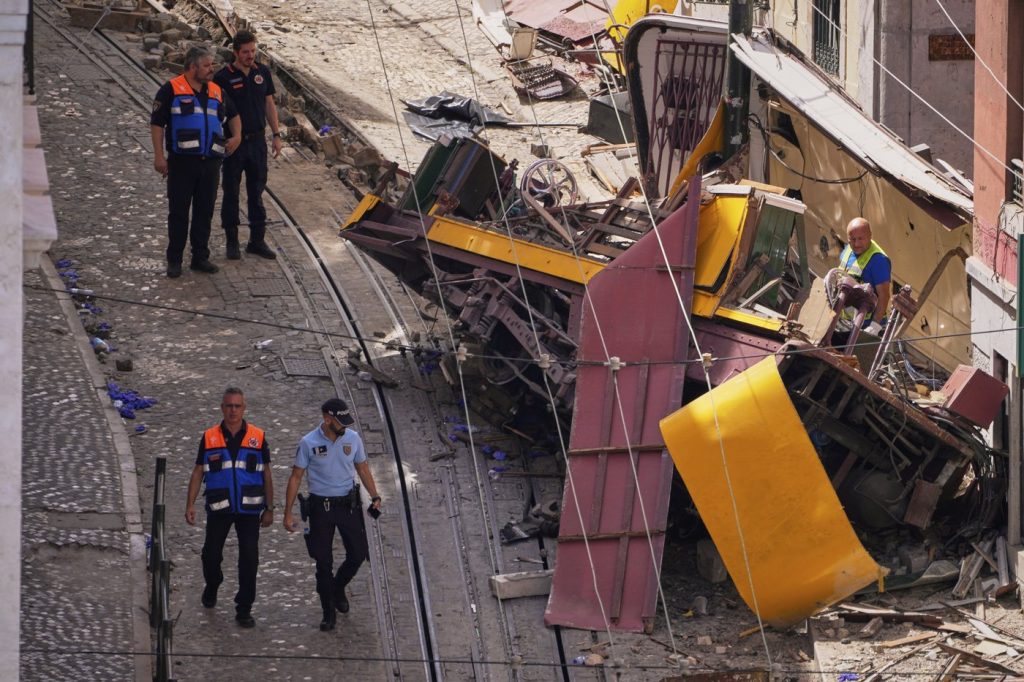LISBON, Portugal (AP) – Details began to emerge regarding the tragic incident involving a streetcar in Portugal’s capital, Lisbon, which derailed, resulting in significant loss of life and multiple injuries. The first investigative report into the cause of this crash, involving the popular tourist attraction known as the Elevador da Gloria, is expected to be released shortly.
The iconic yellow-and-white streetcar, classified as a national monument, was crowded with both locals and tourists when it derailed on Wednesday evening. This horrific event led to 16 fatalities and left 21 others injured. Portugal’s Prime Minister, Luis Montenegro, referred to the incident as "one of the biggest tragedies of our recent past."
Various agencies are conducting investigations into the derailment. The government's Office for Air and Rail Accident Investigations announced the completion of its analysis of the wreckage, intending to issue a preliminary report soon. Chief police investigator Nelson Oliveira indicated that a preliminary police report would be available within 45 days.
As of Thursday, the attorney-general's office confirmed the identification of eight victims, including five Portuguese nationals, two South Koreans, and one Swiss individual. Investigators suspect the possibility of additional victims, including two Canadians, one American, one German, and one Ukrainian. Currently, they are striving to identify three of the deceased individuals.
Among the victims was André Marques, the streetcar's brakeman, according to the transport workers' trade union, SITRA. The injured included a diverse group of individuals from countries such as Spain, Israel, Brazil, Italy, and France, with five individuals remaining in serious condition, as reported by Álvaro Santos Almeida, the executive director of Portugal’s National Health Service.
In a televised address, Prime Minister Montenegro underscored the international implications of the tragedy, noting Lisbon's popularity as a tourist destination, having welcomed about 8.5 million visitors in the previous year. Thursday was marked as a national day of mourning, with hundreds of individuals attending a poignant Mass at the Church of Saint Dominic, including national leaders and local officials.
The Elevador da Gloria, a funicular streetcar, is operated via steel cables and has a capacity of over 40 passengers. Officials have not yet commented on the cause of the accident, which may involve a faulty brake or a snapped cable leading to the streetcar's descent and collision with a building at a sharp bend in the road.
Mayor Carlos Moedas stressed the importance of finding answers regarding the cause of the tragedy, stating that speculation surrounding the issue must be avoided until confirmed details emerge.
Aside from thorough investigations being carried out by police, public prosecutors, and government transport experts, Carris, the company responsible for operating Lisbon's streetcars and buses, has initiated its own inquiry. The streetcar has been in service since 1914 and underwent scheduled maintenance last year. Carris’ CEO Pedro de Brito Bogas revealed that the last visual inspection occurred just nine hours before the derailment, though specifics regarding the inspection protocols were not disclosed.
In response to the incident, Lisbon's City Council temporarily suspended operations of three other funicular streetcars to conduct immediate inspections. Local tourists expressed their shock and concern following the tragedy. British tourist Felicity Ferriter recounted hearing "a horrendous crash" just moments after she arrived at her nearby hotel, noting that they had planned to ride the streetcar the following day. Similarly, Francesca di Bello, a 23-year-old Italian tourist, described her horror after having traveled on the Elevador da Gloria just hours before it derailed. When asked about riding a funicular again, she emphatically stated, “Definitely not.”
The somber atmosphere surrounding the event continues to resonate, as the community grapples with the tragic outcome of this accident and the impact it has had not just on Portugal, but also on the global community of tourists who visit Lisbon.










